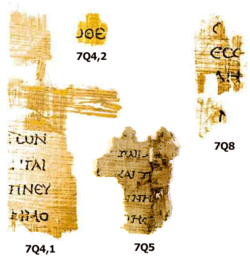| List of the manuscripts from Qumran Cave 7 | |
|---|---|
 Dead Sea Scroll fragments 7Q4, 7Q5, and 7Q8 from Cave 7 in Qumran, written on papyrus | |
| Material | Parchment, papyrus |
| Writing | Greek |
| Created | Est. 408 BCE to 318 CE |
| Discovered | 1952–56 |
| Present location | Qumran |
The following is a list of the Dead Sea Scrolls from the cave 7 near Qumran.